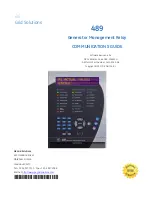
Load circuit relay output (Out 1/2)
To prevent excessive wear and to comply with the EMC regulations interference
suppression of the contacts is required for switching inductive loads.
If the relay is used to switch very small currents (e.g. PLC inputs), considerable con-
tact resistance can arise. In this case use the transistor output.
Load circuit transistor (Out 1/2)
The transistor outputs need an external voltage of 24 V DC at terminal 3. This volt-
age can be taken from the unit via terminal 10.
The reference point (GND) of the external power supply must be connected to ter-
minal 1 of the monitor, otherwise no switching operation is possible.
The device shall be supplied from an isolating source and protected by an overcur-
rent protection device such that the limited voltage circuit requirements in accor-
dance with UL 508 are met.
Analogue output, PWM (Out 3)
The analogue output is not electrically separated from the sensor/transmitter sup-
ply and from the 24V DC supply voltage. No dangerous contact circuits must be
connected to the analogue output.
6. Signal monitoring
The measuring range of the input signals is divided into the operating range, the
warning range and the fault range. For signal monitoring it is useful to connect a
sensor/transmitter with a 4...20 mA output signal.
If an input signal is in the warning or fault range, this is indicated by flashing of
the yellow input LED In1 or In2. The transistor output "output fault" (terminal 12)
is blocked as soon as a signal is in the fault range.
MONITOR
AL-3
29
ENGLISH
operating
range
fault
range
fault
range
warning
range
warning
range
4
20
22
0
3,6
mA
wire
break
The transitions fault range
↔
warning range are equipped with a hysteresis:
< 3.6 mA and > 3.7 mA / > 22 mA and < 21.9 mA
The transitions operating range
→
warning range (< 4 mA, > 20 mA) are
equipped with a delay time t
v
of 500 ms.
















































